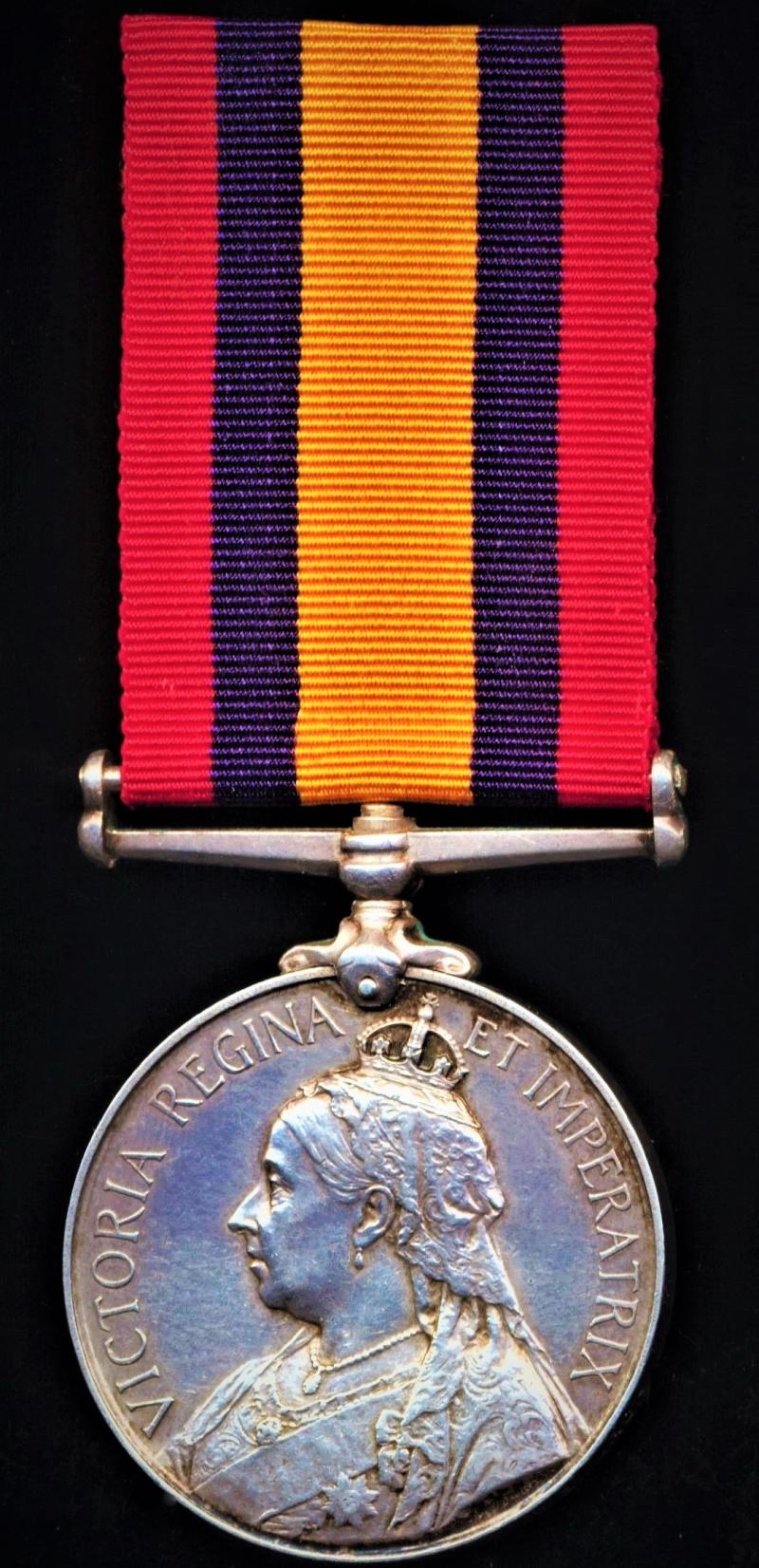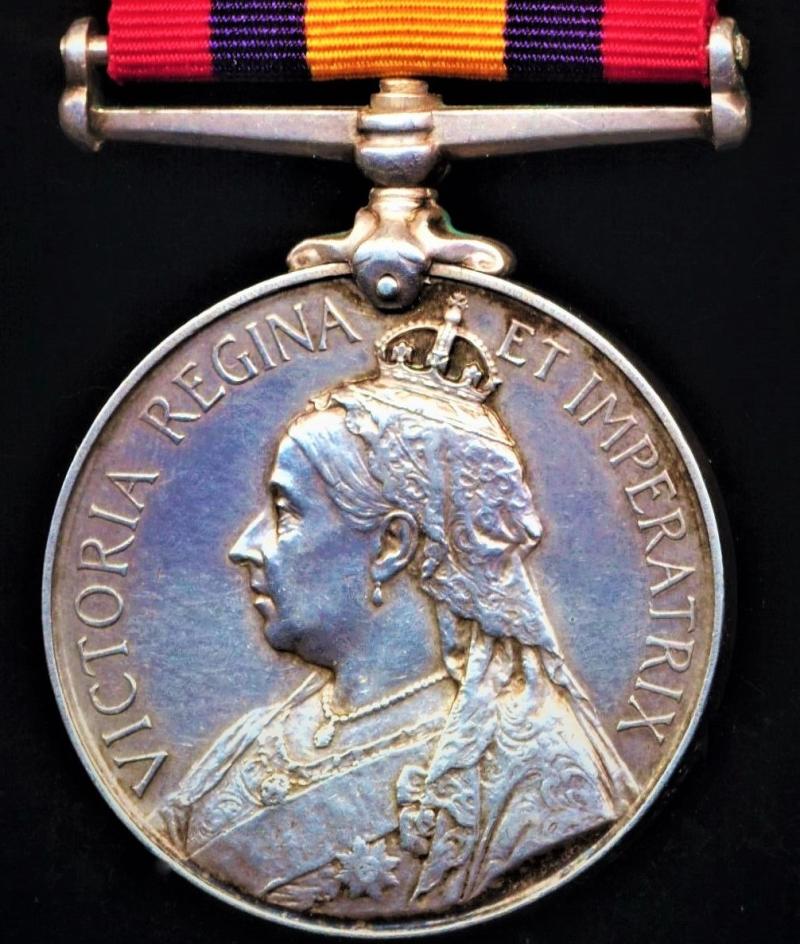Queen's South Africa Medal. Silver issue. No clasp (A. Scannell. Ord: H.M.S. Monarch)
Killed-in-Action 1915: Arthur Scammel is confirmed 'Killed-in-Action' while serving with crew of H.M.S. Lynx, an Acasta Class Destroyer, that was destroyed and sunk on, 9 November 1915, in the waters of the Moray Firth, Scotland, after being hit by a mine that had exploded. The Captain and 70 x crew members were killed and or drowned, with only 26 Officers and members of the crew surviving
Important: Recipient's correct name was Arthur Scamell (sic) - the medal roll shows his name originally recorded as Scannell (as impressed on this his original issue medal), this entry later amended with original name scored out, and above in ink the letter 'M', and above that the name 'Scannel' inserted = and clearly an afterthought! The medal here named exactly as originally issued. A duplicate medal was issued to the recipient in 1913 - and it was at that time the entry was revised, and the duplicate issued to the recipient in the name of Scamell - the amendments and notes about the duplicate issue all in the same ink
Naming: Officially impressed in the original style
Reference 'British Battles & Medals' (Spink, Seventh Edition 2006) show's that the crew of H.M.S. Monarch qualified for 812 x medals with 'no clasps', but less than that were issued, as a total of 171 x medals were 'returned'
Medal verification: The QSA with no clasp, to No. 196859 Ordinary Seaman Arthur Scannell (sic - correct name Scamell), and the other medals the recipient qualified for - are all confirmed per below cited sources:
- QSA Medal: Reference ADM 171/53 (Sent H.M.S. Philomel 7 March 1902)
- 1914-15 Star: Reference ADM 171/114
- British War Medal. Silver issue: Reference ADM 171/114
- Interallied Victory Medal: Reference ADM 171/114
Arthur Scamell, was a native of, Hampshire, England, where he was born on, 3 October 1881. Straight after leaving school, Arthur joined the Royal Navy, on, 16 December 1897. He served aboard H.M.S. Monarch between, 4November to 31 December 1899. Arthur's extant service sheet (held and accessible at The National Archives) shows a very impressive list of capital ships that he served aboard. Prior to the Great War, his most noteworthy service afloat, was as a CREW-member of H.M.S. Waterwitch - the Royal Navy's dedicated Hydrography ship for service on the China Station (he mustered on the Waterwitch, 12 March to 30 September 1912 . Arthur was a member of the 'Waterwitch' when she was holed and sunk in Singapore Colony, on 1st September 1912.
H.M.S. Waterwitch: Reference 'The Straits Times' issue of, 2 September 1912:
Quote,
On 1 September 1912, while lying at anchor off the north-eastern end of the mole at Singapore Harbour, Waterwitch was struck amidships by Seamew, the personal launch of the Governor of Singapore. Seamew had been heading around the breakwater for her usual berth and paid little enough attention to the position of Waterwitch that she drove right at her. The launch's sharp prow pierced Waterwitch's wooden side, and she then compounded her error by putting her engines hard astern. Waterwitch's bridge collapsed, her mainmast fell over the port side, and the resulting gaping wound in her side allowed an overpowering in-rush of water.
Since her fires were out, no power could be raised, and so her anchor watch operated the pumps and a tug took her in tow. The wash from the tug increased the flooding and Waterwitch sank in 24 ft (7.3 m) of water. At low water, her masts, funnel, and the highest parts of her superstructure remained above water. Two members of her ship's company were drowned: Marine Sturgess knocked himself out diving overboard and was drowned, and an unnamed Chinese boy drowned between decks. A Board of Trade inquiry was held at Singapore from 20 to 23 September 1912 and found that the collision was due to the negligence of Seamew's captain and, to a lesser degree, her First Officer and Chief Engineer. At a re-opened inquiry the following month, the two subordinate officers were exonerated
Unquote.
The wreck was raised on 10 September 1912 and taken to drydock at Tanjong Pagar, Singapore. 12 October 1912, Waterwitch was offered for sale "as lies" in drydock
H.M.S. Lynx: Reference the Imperial War Museum, the below summary is provided:
Quote,
HMS Lynx was an Acasta-class destroyer of the Royal Navy. She was built on the River Clyde by London and Glasgow Shipbuilding Company. Lynx was built as yard number 364, and was 267 ft 6 in (81.53 m) in length, 27 ft (8.2 m) in breadth and had a draught of 10 ft 6 in (3.20 m). She was powered by a steam turbine engine which produced 25000 shp. She was commanded from 16 December 1913 by Commander Reginald St Pierre Parry. Lynx was part of the response to the German bombardment of Scarborough on 16 December 1914. At 05:15 she sighted the German destroyer SMS V155, and summoned her destroyer squadron to investigate. The brief skirmish took place with a force of German destroyers and cruisers, and Lynx was hit several times by German shells. She sustained minor damage to a propeller, and had one man wounded. Lynx left Cromarty with two half-divisions of the Fourth Destroyer Flotilla on 15 December 1914 and she encountered a German destroyer. Lynx was hit by gunfire as she gave chase and her forward magazine was flooded. Her steering gear jammed and the rest of the force made the error of following her, thus ending the pursuit. On 9 August 1915 Lynx struck a mine off the Moray Firth and sank. The ship was, at the time, serving in the North Scottish waters during the First World War. 70 men, including Commander John Francis Herbert Cole, were lost. Four officers and twenty-two ratings survived. The mine had been laid by the German raider Meteor.
Unquote.
The recipients naval service sheet is extant and is held and accessible at The National Archives
Condition: About GVF
Code: 22788







